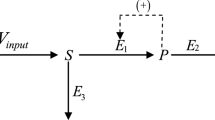Abstract
The dynamic behavior of some non-linear extensions of the six-state alternating access model for active membrane transport is investigated. We use stoichiometric network analysis to study the stability of steady states. The bifurcation analysis has been done through standard numerical methods. For the usual six-state model we have proved that there is only one steady state, which is globally asymptotically stable. When we added an autocatalytic step we found self-oscillations. For the competition between a monomer cycle and a dimer cycle, with steps of dimer formation, we have also found self-oscillations. We have also studied models involving the formation of a complex with other molecules. The addition of two steps for formation of a complex of the monomer with another molecule does not alter either the number or the stability of steady states of the basic six-state model. The model which combines the formation of a complex with an autocatalytic step shows both self-oscillations and multiple steady states. The results lead us to conclude that oscillations could be produced by active membrane transport systems if the transport cycle contains a sufficiently large number of steps (six in the present case) and is coupled to at least one autocatalytic reaction. Oscillations are also predicted when the monomer cycle is coupled to a dimer cycle. In fact, the autocatalytic reaction can be seen as a simplification of the model involving competition between monomer and dimer cycles, which seems to be a more realistic description of biological systems. A self-regulation mechanism of the pumps, related to the multiple stationary states, is expected only for a combined effect of autocatalysis and formation of complexes with other molecules. Within the six-state model this model also leads to oscillation.
Similar content being viewed by others
References
Abhyankar SS (1990) Algebraic geometry for scientists and engineers. AMS, Providence, Rhode-Island
Adamo HP, Rega FA, Garrahan PJ (1990) Pre-steady-state phosphorylation of the humen red cell Ca2+-ATPase. J Biol Chem 265:3789–3792
Andersen JP (1989) Monomer-oligomer equilibrium of sarcoplasmic reticulum Ca-ATPase and the role of subunit interaction in the Ca2+ pump mechanism. Biochim Biophys Acta 988:47–72
Betts GF, Srivastava DK (1991) The rationalization of high enzyme concentration in metabolic pathways such as glycolysis. J Theor Biol 151:155–167
Clarke BL (1975) Stability of topologically similar networks. J Chem Phys 62:3726–3738
Clarke BL (1980) Stability of complex reaction networks. In: Prigogine I, Rice SA (eds) Advances in chemical physics, Vol 43. Wiley, New York, pp 1–213
Clarke BL (1981) Complete set of steady state for the general stoichiometric dynamical systems. J Chem Phys 75:4970–4979
Daoyi X (1985) Simple criteria for stability of interval matrices. Int J Control 41:289–295
Feinberg M (1972) Complex balancing in general kinetic systems. Arch Rational Mech Anal 49:187–194
Feinberg M (1987) Chemical reaction network structure and the stability of complex isothermal reactors — I. Chem Eng Sci 42: 2229–2268
Feinberg M (1988) Chemical reaction network structure and the stability of complex isothermal reactors — II. Chem Eng Sci 43: 1–25
Goldbeter A, Dupont G, Berridge MJ (1990) Minimal model for signal-induced Ca2+ oscillations and their frequency encoding through protein phosphorylation. Proc Nacl Acad Sci, USA 87:1461–1465
Guckenheimer J, Holmes P (1983) Nonlinear oscillations, dynamical systems and bifurcation of vector fields. Springer, New York Berlin Heidelberg
Horn FJ (1972) Necessary and sufficient conditions for complex balancing in chemical kinetics. Arch Rational Mech Anal 49:172–186
Horn FJ, Jackson R (1972) General mass action kinetics. Arch Rational Mech Anal 47:81–116
Kosk-Kosicka D, Bzdega T (1988) Activation of the erythrocyte Ca2+ ATPase by either self-association or interaction with calmodulin. J Biol Chem 263:18184–18189
Kosk-Kosicka D, Bzdega T (1988) Activation of the erythrocyte Ca2+ ATPase by either self-association or interaction with calmodulin. J Biol Chem 263:18184–18189
Kosk-Kosicka D, Bzdega T (1990) Effects of calmodulin on erythrocyte Ca2+-ATPase activation and oligomerization. Biochemistry 29:3772–3776
Kubiček M, Marek M (1983) Computational methods in bifurcation theory and dissipative structures. Springer, New York Berlin Heidelberg
Läuger P (1984) Thermodynamic and kinetic properties of electrogenic ion pumps. Biochim Biophys Acta 779:307–341
Lemieux DR, Koosey JM (1991) Simulation of the voltage dependence of the Na, Ka pump applied to cardiac cells. J Theor Biol 150:73–91
Mayer EA, Konder A, Sun XP, Wilkes J, Scott D, Sachs G (1992) Spatial and temporal patterns of intracellular calcium in colonic smooth muscle. J Membrane Biol 125:107–118
Nicolis G, Prigogine I (1977) Self-organization in non-equilibrium systems. Wiley, New York
Palis J, Melo W (1982) Geometric theory of dynamical systems: an introduction. Springer, New York Berlin Heidelberg
Petersen OH, Wakui MI (1990) Oscillating intracellular Ca2+ signals evoked by activation of receptors linked to inusitol lipid hydrolysis: mechanism of generation. J Membrane Biol 118:93–105
Repke KRH (1986) A model for allosteric regulation of Na+/K+ transporting ATPase. Biochim Biophys Acta 864:195–212
Seydel R (1988) From equilibrium to chaos. Practical bifurcation and stability analysis. Elsevier, New York
Tanford C (1983) Mechanism of free energy coupling in active transport. Annu Rev Biochem 52:379–409
Tepikin AT, Voronin SG, Gallacher DV, Petersen OH (1992) Pulsatile Ca+ extrusion from single pancreatic acinar cells during receptor-activated cytosolic Ca+ spiking. J Biol Chem 267: 14073–14076
Ueda T, Matsumoto K, Akitaya T, Kobatake Y (1986) Spatial and temporal organization of intracellular adenine nucleotides in relation to rhythmic motility in Physarum plasmodium. Exp Cell Res 162:486–494
Weissmüller G, Bisch PM (1993) Autocatalytic cooperativity and self-regulation of ATPase pumps in membrane active transport. Eur Biophys J 22:63–70
Willamowski KD (1978) Contributions to the theory of mass action kinetics – III. Z Natür 33a:989–992
Yoshimoto Y, Kamiya N (1982) Ca Z+ oscillations in the homogenate of Physarum plasmodium. Protoplasma 110:63–65
Author information
Authors and Affiliations
Additional information
Correspondence to: P. M. Bisch
Rights and permissions
About this article
Cite this article
Vieira, R.M.C., Bisch, P.M. Oscillations and multiple steady states in active membrane transport models. Eur Biophys J 23, 277–287 (1994). https://doi.org/10.1007/BF00213577
Received:
Accepted:
Issue Date:
DOI: https://doi.org/10.1007/BF00213577




